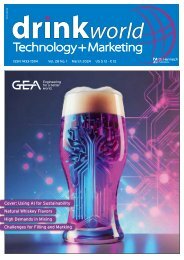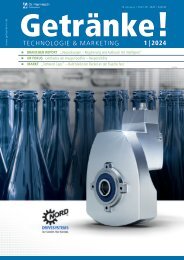drinkworld Technology + Marketing 1/2023
drinkworld Technology + Marketing is the leading magazine for the entire drinks industry worldwide. Feature articles and short communications cover the whole spectrum of processing, bottling, raw materials, logistics, packaging and marketing of beverages. We also report on special topics of regional interest and the trends in the beverage industries worldwide. Readers are executives and decision-makers in the brewing, dairy and mineral water industries, manufacturers of non-alcoholic drinks, wine growers and bottlers.
drinkworld Technology + Marketing is the leading magazine for the entire drinks industry worldwide. Feature articles and short communications cover the whole spectrum of processing, bottling, raw materials, logistics, packaging and marketing of beverages. We also report on special topics of regional interest and the trends in the beverage industries worldwide. Readers are executives and decision-makers in the brewing, dairy and mineral water industries, manufacturers of non-alcoholic drinks, wine growers and bottlers.
You also want an ePaper? Increase the reach of your titles
YUMPU automatically turns print PDFs into web optimized ePapers that Google loves.
Processing<br />
is clear, a switch is made to the wort<br />
kettle. During the lautering process,<br />
the JUMO TAROS S46 H measures the<br />
differential pressure under the drop<br />
bottom to control the rotational speed<br />
of the frequency-controlled pump and<br />
to switch on the chopper if necessary.<br />
After the main pour has been completed<br />
the post pours follow. The quantity of<br />
the individual post pours is acquired<br />
again via the JUMO flowTRANS US<br />
W01/02. Post-pouring is intended to<br />
remove any remaining extract from the<br />
spent grains. The sum of the extract<br />
that can be washed out and degraded<br />
should be less than 1 %.<br />
In the subsequent process step, the wort<br />
is boiled for approximately 70 to 90<br />
minutes. Boiling evaporates the water<br />
to obtain the required original wort,<br />
expels unwanted aroma substances,<br />
sterilizes the wort, inactivates enzymes,<br />
and forms aroma as well as colorants.<br />
During boiling the hops are also added<br />
to the wort. This can be done in several<br />
individual hop dosages, depending on<br />
the beer and hop varieties. For bitter<br />
hops, the boiling process improves the<br />
dissolution of the bitter substances<br />
which is why they are usually added to<br />
the mix at the beginning. Aroma hops,<br />
on the other hand, are only added<br />
towards the end of boiling. The hop<br />
varieties used for the anniversary beer<br />
were magnum, ariana, and saphir.<br />
After boiling the wort is cooled down to<br />
20 °C. This is done with a countercurrent<br />
heat exchanger. At the outlet, the JUMO<br />
flowTRANS MAG H20 acquires both the<br />
totalized flow rate and the temperature.<br />
The rotational speed of the wort pump<br />
is controlled as a function of the wort<br />
outlet temperature.<br />
After the preparation with yeast comes<br />
the fermentation and storage of the<br />
beer. Precise temperature control<br />
plays a particularly important role in<br />
fermentation. While beers with topfermented<br />
yeast ferment between 15<br />
and 20 °C, bottom-fermented yeasts<br />
ferment in a range of 4 to 9 °C.<br />
JUMO digiLine CI HT10<br />
determines concentration of<br />
cleaning media<br />
Automatic cleaning of the equipment<br />
is also an option. The CIP function<br />
is made possible by such factors as<br />
concentration measurement of the<br />
cleaning media. JUMO digiLine CI<br />
HT10 determines the concentration<br />
of the different cleaning media<br />
via the temperature-compensated<br />
conductance in the hot water<br />
container.<br />
Another measurement is used at<br />
the plant discharge to monitor the<br />
individual cleaning steps and media<br />
separation. First, the plant is preflushed<br />
with water via the spray heads in the<br />
containers. Subsequently, the cleaning<br />
steps with caustic soda, another rinsing<br />
with water, and neutralization with nitric<br />
acid or phosphoric acid follow. The last<br />
step is the final rinse with water until<br />
the conductance detects the complete<br />
removal of the acid at the outlet.<br />
to the reduction of service water and<br />
cleaning agents.<br />
CIP processes can also be carried<br />
out in a comparable manner in the<br />
pharmaceutical industry. In this case,<br />
the last rinse takes place with ultra-pure<br />
water. The conductance of the ultra-pure<br />
water is determined using the JUMO<br />
tecLine CR conductivity sensor and<br />
the JUMO AQUIS 500 CR transmitter.<br />
According to the specifications of USP<br />
645 the temperature compensation<br />
can be deactivated in this case.<br />
Control and visualization<br />
Operation of the plant takes place<br />
via the JUMO variTRON 500 touch<br />
controller and the JUMO smartWARE<br />
SCADA software for process monitoring<br />
and control.<br />
The recipes for the individual beer<br />
types as well as the individual CIP<br />
functions can be configured intuitively<br />
without programming skills using<br />
the browser-based software solution<br />
JUMO smartWARE Program. JUMO<br />
smartWARE Evaluation enables<br />
additional recording of all process<br />
parameters.<br />
"Subsequently, both the brewing<br />
process and the CIP process can<br />
be evaluated and verified with an<br />
automated batch report," says Martin<br />
Eppinger, market segment manager<br />
for food and beverage at JUMO. This<br />
simplifies the brewing process for<br />
the next beer, which can then also be<br />
thoroughly enjoyed.<br />
Martin Eppinger<br />
This is where the JUMO digiLine CI<br />
HT10 shows its strength. The accurate<br />
concentration measurement and<br />
short response time of the integrated<br />
temperature measurement contribute<br />
22


















